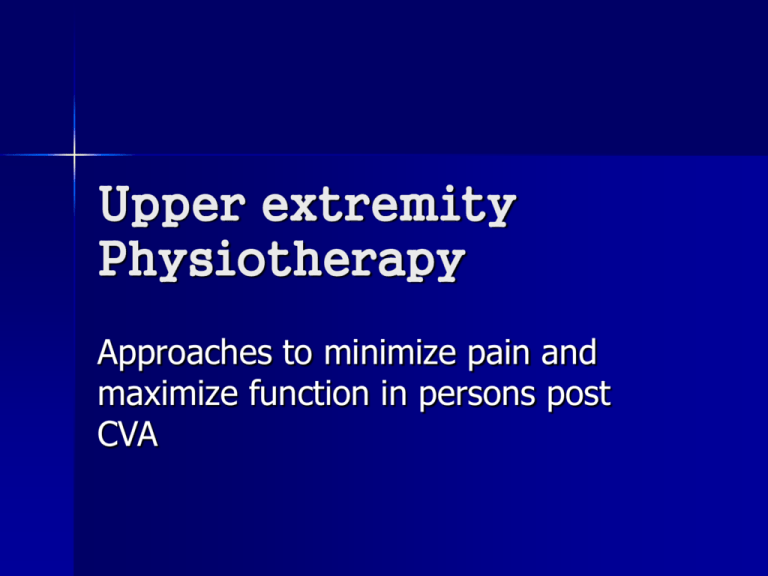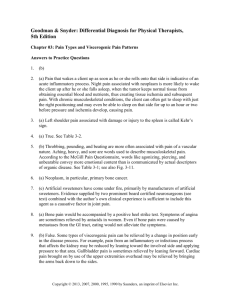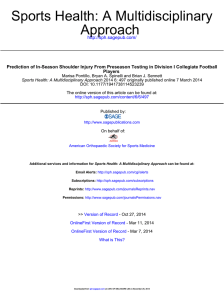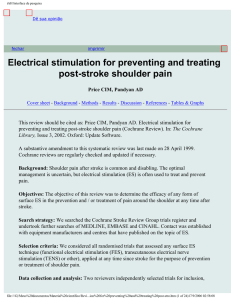Upper extremity Physiotherapy
advertisement

Upper extremity Physiotherapy Approaches to minimize pain and maximize function in persons post CVA Acknowledgements Canadian Stroke Strategy: Best Practice Recommendations and Performance Measures Evidence-Based Review of Stroke Rehabilitation Stroke Canada Optimization of Rehabilitation through Evidence (SCORE) Upper limb post CVA Flaccid – No muscle reaction to passive movement and no voluntary movement and no reflexive reaction High tone – Velocity dependant increase in resistance to passive stretch accompanied by hyperactive stretch reflexes Causes of Shoulder Pain Muscle Imbalance Fracture Tendonitis Glenohumeral Subluxation Bursitis Adhesive Capsulitis Neuropathic (RSD) Muscle Imbalance Disorganized muscle activation Flexor tone predominates in the hemiplegic upper extremity and results in scapular retraction and depression as well as internal rotation and adduction of the shoulder Current research suggests relation between spasticity and shoulder pain Also relation between CVA, frozen shoulder and pain Shoulder subluxation Occurs in a large percentage of persons post stroke with flaccid upper extremity (29-82%) Possibly a reason for development of pain but inconclusive Injury Rotator cuff injury is a possibility however no studies showing conclusive evidence of a tear causing pain Also tears found may not be premorbid – Questionable cause of pain Shoulder pain post CVA: Management Prevention is the NUMBER 1 action for health care providers – There is no one specific treatment for the reduction and elimination of shoulder pain post stroke currently Pain Prevention Positioning Pain prevention Passive range of motion – Recommended to avoid shoulder ranging past 90 degrees of flexion and abduction. – Emphasis on external rotation as tolerated Slings and straps – Perhaps some benefit to prevent shoulder subluxation however little evidence for pain reduction or prevention Slings Slings http://shop.ebay.ca/items/_W0QQ_nkwZar mQ20slingsQQ_armrsZ1QQ_dmdZ2QQ_from Z http://www.lifesolutionsplus.com/harrishemi-arm-sling-p-301.html http://www.sammonspreston.ca/app.aspx?c md=get_product&id=76118 http://www.sammonspreston.ca/app.aspx?c md=get_product&id=97428 Pain treatment Active treatment – Overhead pulleys shown to create pain – Moderate evidence showing gentle exercises are preferred approach – Limited evidence that nonsteroidal antiinflamatory medication improves pain, ROM and function – Sustained stretch may be as equally harmful as immobile position decreasing range and increasing pain Pain Treatment Modalities – Functional electrical stimulation Conflicting evidence http://www.google.ca/search?hl=en&q=functional+electrical+s timulation+shoulder+pictures&meta= Conclusions of shoulder pain Protection – Position properly – Use devices consistently – Patient and family education Passive ranging – Light movement no further than 90 degrees of shoulder flexion and abduction – Emphasis on maintaining external rotation and abduction CIMT CIMT-Constraint induced movement therapy Introduced by Edward Taub in the 1960s after working with deafferented monkeys Phrasing learned non-use Monkeys unaffected arms were restrained in slings and affected arms regained movement Video http://www.youtube.com/watch?v=MMTh2hWvB2g EXCITE Trial 222 participants, 3-9 month period Multi-site, single blinded randomized Inclusion: – 20 degrees wrist extension, 10 degrees MCP and IP extension (high function) – 10 degrees wrist extension, 10 degrees thumb abduction, and 10 degrees extension of at least 2 digits (low function) EXCITE Trial Glove on for 90% of waking hours to less-impaired arm Task practice in lab 6 hours per day, for 2 work weeks (10 days) Conclusion: – Improved function shown to be retained 24 months after 2 week program in SIS strength, ADLs, and social participation Modified CIMT: Page et al. 2008 Stroke was 12 + months prior 20 degrees wrist, 10 degrees MCP and IP extension Restraint for 5 hours per day, with 30 minute one-on-one sessions 3 times per week for 10 weeks Modified CIMT: Page et al. 2008 Conclusion: – Improvement in function and quality of arm movement – May be more practical program than previous studies More local input Ploughman et al. 2008 – Case study from the Miller Rehabilitation Centre in Newfoundland – Same parameters as EXCITE trial – Demonstrated remarkable increase in function for a hockey loving adolescent male Feasibility in NB hospital Inpatient rehab – Glove is cheap and easy to create – Could be used on appropriate patients with consent – Dressing, feeding, toileting would all take more time therefore need health care team, patient and family buy in Feasibility in NB Outpatient CIMT – Labour intensive but there is suggested long term effect – Modified CIMT may be beneficial – Possibility for group therapy sessions – Possible treatment at chronic stage Questions?








